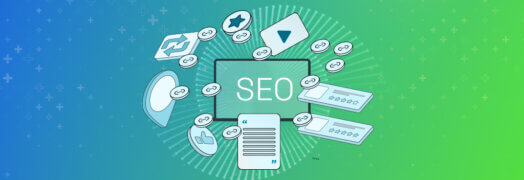Co-authored by Kara Jensen, Creative Principal, Laura Magnuson, Art Director, Daniela Warren, Design Director, Alisa Brenner, Designer
No one can predict the future. Or can they? At Bop Design, our B2B web designers have been practicing their fortunetelling skills for what’s next in 2023. In this post, we’ve compiled their top 8 B2B website design trends to watch out for in the next year.
If you are redesigning or refreshing your B2B website design in 2023, check out what’s on trend and if it makes sense for your website. Join us on the journey to 2023 website trends:
1. Motion Graphics
Video
While video content isn’t exactly new, its widespread popularity has changed the branded internet landscape as we know it. Short-form video is dominating thanks to social media apps like TikTok and BeReal. This video format is going to be wildly popular on company landing and product information web pages.


(Source: Y.CO)
(Source: Bienville Capital)


(Source: RielloSistemi)

(Source: Purple)
(Source: Accenture)
Parallax Scrolling
Parallax scrolling is already a popular tool for making sections of a web page more dynamic. It’s often used in full-width applications along with image, video, or texture imagery to add depth to a page. As the user scrolls past the image or video, the scrolling behavior makes it seem as though the image is placed behind the neighboring sections.


(Source: On Corps AI)
(Source: Plink)
Micro Animations
Micro animations are extremely helpful when it comes to guiding users through your B2B website. Another big trend that we are seeing is animating a cursor, shapes following the cursor, and creating an effect, like “kinetic type.” While some find these animations annoying or negatively impacting the website load time, it’s still on trend for 2023. Why? Because modifying the form of the cursor or implementing cursor-triggered animations engages the website visitor.


(Source: Skillsoft)
(Source: imotion factory)
Kinetic Type
Typing in the headline and other text animations, including scrolling text, will be big in 2023.


(Source: Databricks)
(Source: Future London Academy)
Get more info: Download the B2B website buyer’s guide.
2. Dark Mode First Mindset
Dark mode has been here for a few years, but it’s become more commonplace as it makes for easier reading and improves nighttime visibility. Besides its prominence in mobile operating systems, it has also become a go-to UI structure for B2B website design. Designers who utilize this trend incorporate bright, single pops of bold color to help the visitor navigate through web pages.
Dark Mode
Dark mode helps reduce eye strain as we spend more time looking at screens. Additionally, visually dark mode creates an ultra-modern feel. It is more popular in the technology and cybersecurity sectors as many industries view dark as undesirable, but we expect it to catch on in many other industries by the end of the year.


(Source: SpaceX)
(Source: Spotify)
White Space
White space is about giving content room to breathe and providing a more relaxing scrolling experience. It exudes the confidence of a seasoned storyteller who takes a pause before making an impactful statement. As a result, the content stands out and readability is improved.
While some clients are terrified of “empty” and “wasted” space, it should be viewed as an element in storytelling rather than as real estate to be built out.


(Source: DocuSign)

(Source: Qualtrics)

(Source: Fivetran)
(Source: formlabs)
3. Bold, Organic Shapes + Swiss Design
To make a product, message, or website stand out in 2023, designers are turning to bold abstract shapes. These elements add an additional layer of visual interest without distracting from a graphic’s main focus.
While asymmetric style will continue in 2023, we’ll see more traditional “Swiss” designs with rules, simple sans-serif fonts, and multiple columns. This look provides a utilitarian and modern feel, providing a blend of a progressive yet stable and traditional feel. It is most useful in the technology space and in very complex design systems. A great example is IBM.
Art Deco will also be popular in 2023 B2B website design aesthetics as it is based on symmetrical and geometric shapes. This style is often patterned, decorative, and ornamental. Geometric shapes help to reduce visual stress and provide a smooth experience.
Geometric shapes were a big website design trend in 2020, but in 2023, we’ll see more organic, morphed, fluid shapes. A clear example is Spotify and Android using circles behind products and copy.

(Source: Spotify.com/wellness)


(Source: Tableau)

(Source: Sprig)
(Source: Nuvolo)
4. Typography-Driven Designs
Simplicity is the name of the game with an emerging trend of text-only hero images. This new trend catches the visitor’s attention by removing the background image in the hero section and replacing it with eye-catching typography that is bold, big, and straightforward.

(Source: Reachdesk)

(Source: Poggio Labs)

(Source: Emergence Capital)
Full-Page Headers and Full-Height Homepage Hero
Heatmaps and tracking tell us that visitors tend to focus their attention on the top-left portion of a website page. As such, designers are now using large text and call-to-action buttons on the left of the header and enticing graphics to the right. Similar to the text-only hero, full-height focuses the user’s attention on distraction-free messaging.
The Return of San Serif Fonts
Serif logos are beginning to reach saturation point, which is why designers are adding freshness with geometric sans or grotesque Swiss-style typefaces (or indeed, a more evolved version of the serif, see Flared Fonts, below).
Sans serifs not only curate a clean, minimalist style for branding, packaging, and other print designs, but they also improve legibility and accessibility on apps and B2B websites. As more brands tune into the need for digital output to be fully accessible, we can expect sans serifs to take on a more dominant role online.
(Source: ServiceNow)
(Source: Stedelijk Museum of Modern and Contemporary Art and Design)
5. Interactive Data Visualization and 3D Elements
This is an emerging trend that has been most popular in the game design, museum, and engineering sectors. Opportunities for interactive 3D experiences continue to grow as the web speeds up. Often requiring experienced coding and/or 3D modeling artists, this trend should not be undertaken lightly. If executed properly for the B2B space, this trend has the potential to create new levels of depth and interest through 3D interactivity.
Creating images out of data is an engaging way for visitors to learn more about a brand. While some prefer to look at numbers and read copy, most website visitors like infographics and graphs to help them quickly understand the point.

(Source: CalicoLabs)


(Source: Snowflake)

(Source: Uplinq)
(Source: CLOU Architects)
6. Content Layering for Space
As we mentioned earlier, white space with enough breathing room for copy and graphics to stand out is here to stay for B2B web design in 2023. The trend is expanding to include the organizing of related content or benefits in click-throughs or animated containers continues. This content layering is often popular with SaaS companies that are relaying complex ideas in a short amount of time. This layering approach provides more space to showcase supporting visuals for each value proposition.

(Source: Twilio Segment)


(Source: Southbank Centre)

(Source: UKG)
(Source: eduMe)
7. Grainy Gradients and Frosted Glass Effects
Gradients are a long-time trend that we expect to evolve in the coming year. They add depth to a text-heavy design and add texture and a 3D feel to illustrations. Look for big bold typography with static, animated, or parallax gradients on websites launching in 2023.
Advances in web technology have allowed for easy implementation of the frosted glass effect. This type of B2B website design effect adds color to an area while also allowing text to be legible over an image.


(Source: Dynatrace)

(Source: Catalyst)

(Source: Tekpon)
(Source: Stripe)
8. Accessibility
The demand for website accessibility is on the rise for B2B companies. Website accessibility is the practice of making B2B websites usable for all visitors, including those with visual, auditory, or cognitive disabilities. Making a website accessible affects all aspects of the visual design, as well as content and development. While it’s not a legal requirement for most B2B companies, it’s becoming an important goal. Making a website more accessible does include sacrificing certain design elements, but it provides better access to your content for more users.


(Source: Partake Foods)
(Source: GOV.UK)





